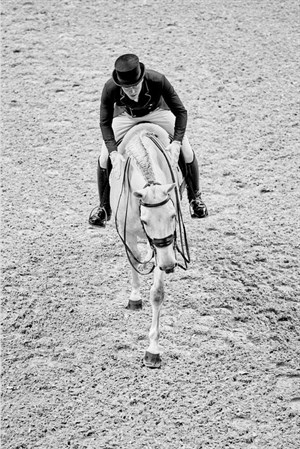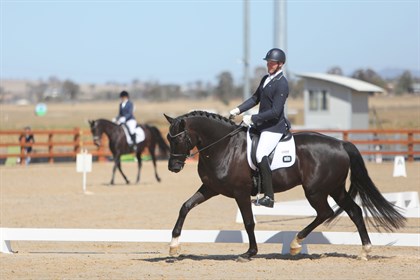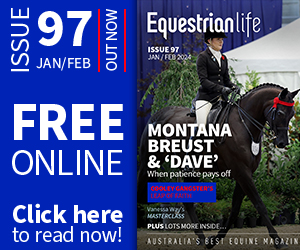|

|
This article has appeared previously with Equestrian Life. To see what is in our latest digital issue, please click here.

Joao Victor Macari Oliva (BRA) at the World Cup Final. Image: Liz Gregg/FEI.
Where did all my marks go? (Part 1)
By Roger Fitzhardinge
So I am pretty lucky, I am able to ride two horses every day, and then coach other riders to be more competitive. I am able to sit and judge riders, and horses, and get arguably the best seat in the dressage world (the judges perspective) where I can put marks and comments to paper, feeling confident that I am able to substantiate every one of them as I realize how hard it is to get each and every mark!
But believe me this is not an easy task, the good horses make mistakes, the better horses lack riders who pay attention to detail and in turn throw marks away. So then the “average” horses make no mistakes, and hey presto you have a winner who is “average”. That is, they have average marks, average everything, no flashy bits - just good honest training and every movement for a fairly good mark (usually a 7) with a few great halts (a great halt is often undervalued), fluent and there you have it - 70+% and a win!
Can I say that any rider who is a serious competitor must sit and judge. If not in an official capacity, then at least with a test sheet and pen in hand, to put marks from one to ten on the paper after each and every movement. No delay here and shoot from the mind and not the heart. It’s even more interesting to mark your own test that was videoed, and look at it as if it’s not you but someone else, and be very honest. Here lies a problem! If you don’t judge at all and have no concept of what to be looking for, instead of only your feel, then it’s very hard to be able to improve your test.
When you sit in a car for 5 hours and judge 30 horses on a sunny wonderful spring Sunday, you soon realize how hard it is to remain focused, positive, consistent, keep calm and patient when you see mistakes that are so easily rectifiable. In the Novice 2C, for every 3.2 marks you lose, its actually ONE percentage!!!! People don’t realise it’s so easy to lose marks.
So, let’s analyse a Novice test ...
Your job as a rider starts before you even think of entering the warm up. I need not go into the training here, as this is a book in itself and the regime varies from rider to rider and horse to horse on a very individual scheme. But I can say that for me, as a judge sitting at C, the first impression is seriously important, as it sets a tone and a mood between the judge and the rider. As a judge,when you first see the horse trot, walk or canter around the arena towards the C end, it’s only human nature to feed off what you see. It’s a mood, and attitude and an outlook that is set even before you enter the ring.

Robert Schmerglatt and Asterix ride a Novice test. Image: Roger Fitzhardinge.
Having judged the 2C at the Sydney Equestrian competition it was so interesting to realise where and why riders threw away marks, and what made me as a judge, confident to give marks and in turn what annoyed me and then not give marks.
It was an official class, and one that would qualify for State and National competitions so it's always of the utmost importance for judges to stay true to the marks. A 7 is a 7 - whether at Upper Kumbukka West show, a Pony Club competition or an event at a State or National show. With this in mind when I was judging, it was my first impression that was important as this impression was lasting. When the competitor first came in to sight and was traveling around the arena, we have a look to see if we think this could be the winning test!
So what is the quality that makes me stop and say WOW?
Primarily it’s the schooling. The “feeling” that the horse is obedient, confident, has good expression and the rider looks comfortable. BUT if you have two horses that have this schooled look of round and through, and one is hairy and not plaited, with dirty gear, an “unproud” rider who is not well presented (clean etc), then the horse that is beautifully conditioned, groomed and a rider in clean, well fitting gear, with clean and well fitting saddlery will be the combination that will draw attention. This attention to detail adds that X factor, that “look at me”, that feeling of showing the judge the rider cares and are serious. This is what demands the judges attention. Correct dressage training will produce a horse with muscles in the right places, that will in turn make the horse a more comfortable ride which makes the overall look more comfortable.
Anyway, I am sure you get what I am trying to say in regards to presentation and making an impression. Of course it is also of the utmost importance that we as judges award the correct mark for each movement. This is based on the horses own movement, carriage and training not on the shiniest coat and the best plaits. Needless to say it is always the overall picture that you are judging, and so conditioning and all of the above is so applicable in getting the whole "look".
It's often one mark that makes the difference, so don’t miss out the chance to make points for attention. Well presented horses and riders give a judge a feeling of the importance the rider puts on their sport and horse.
My Presentation Pet Hates
- martingale stoppers on reins
- too much bling
- saddlecloths that kick up at the back
- dirty top boots
- straps not in keepers - especially the saddles that have a strap from the saddle flap and it's loose with the tail not in the keeper which then flaps around behind the horses front legs
- half a sheep as a poll cover
- the hanoverian strap that has no keeper and flaps around the horses nose
- riders who lack any positivity in the minute around the arena before entering
- when at the salute, if carrying a whip the rider holds it in the saluting hand and it touches the horse - it should be in the hand that holds the reins
Read Part 2 here.
READ THE LATEST NEWS ARTICLES HERE

|

|

